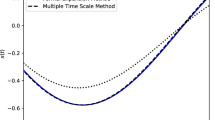Abstract
GivenA 1, the discrete approximation of a linear self-adjoint partial differential operator, the smallest few eigenvalues and eigenvectors ofA 1 are computed by the homotopy (continuation) method. The idea of the method is very simple. From some initial operatorA 0 with known eigenvalues and eigenvectors, define the homotopyH(t)=(1−t)A 0+tA1, 0≤t≤1. If the eigenvectors ofH(t 0) are known, then they are used to determine the eigenpairs ofH(t 0+dt) via the Rayleigh quotient iteration, for some value ofdt. This is repeated untilt becomes 1, when the solution to the original problem is found. A fundamental problem is the selection of the step sizedt. A simple criterion to selectdt is given. It is shown that the iterative solver used to find the eigenvector at each step can be stabilized by applying a low-rank perturbation to the relevant matrix. By carrying out a small part of the calculation in higher precision, it is demonstrated that eigenvectors corresponding to clustered eigenvalues can be computed to high accuracy. Some numerical results for the Schrödinger eigenvalue problem are given. This algorithm will also be used to compute the bifurcation point of a parametrized partial differential equation.
Similar content being viewed by others
References
E.L. Allgower and K. Georg,Numerical Continuation Methods (Springer, 1990).
J.K. Cullum and R.A. Willoughby,Lanczos Algorithms for Large Symmetric Eigenvalue Computations, Vol. I:Theory (Birkhäuser, 1985).
E. Giladi, On the interplay between inner and outer iterations for a class of iterative methods, in:Colorado Conf. on Iterative Methods, Brechenridge, CO (1994).
G. Golub and C. van Loan,Matrix Computations, 2nd ed. (John Hopkins U. P., Baltimore, 1989).
L.A. Hageman and D.M. Young,Applied Iterative Methods (Academic Press, 1981).
L.J. Huang, Parallel Homotopy Algorithm for large sparse symmetric eigenproblems, PhD thesis, Michigan State University (1992).
T. Kato,A Short Introduction to Perturbation Theory for Linear Operators (Springer, 1982).
H.B. Keller,Lectures on Numerical Methods in Bifurcation Problems (Springer, Berlin, 1987), Tata Institute of Fundamental Research, Bombay, India.
K. Li and T.Y. Li, An algorithm for symmetric tridiagonal eigenproblems: Divide and conquer with homotopy continuation, SIAM J. Sci. Comp. 14 (1993) 735–751.
T.Y. Li and N.H. Rhee, Homotopy algorithm for symmetric eigenvalue problems, Numer. Math. 55 (1989) 265–280.
T.Y. Li, H. Zang and X.H. Sun, Parallel homotopy algorithm for the symmetric tridiagonal eigenvalue problem, SIAM J. Sci. Comp. 12 (1991) 469–487.
T.Y. Li and Z. Zeng, Homotopy-determinant algorithm for solving non-symmetric eigenvalue problems, Math. Comp. 59 (1992) 483–502.
T.Y. Li, Z. Zeng and L. Cong, Solving eigenvalue problems of real nonsymmetric matrices with real homotopies, SIAM J. Numer. Anal. 29 (1992) 229–248.
S.H. Lui, H.B. Keller and T.W.C. Kwok, Parallel homotopy method for the large sparse nonsymmetric eigenvalue problem, SIAM J. Matrix Anal. Appl. (1994), submitted.
M. Oettli, A homotopy method applied to eigenvalue problems, Tech. Rep., ETH (1993).
C.C. Paige and M.A. Saunders, Solutions of sparse indefinite systems of linear equations, SIAM J. Numer. Anal. 12 (1975) 617–629.
C.C. Paige, G.P.H. Styan and P.G. Wachter, Computation of the stationary distribution of a Markov chain, J. Statist. Comp. Simul. 4 (1975) 173–186.
B.N. Parlett,The Symmetric Eigenvalue Problem (Prentice-Hall, 1980).
G. Peters and J.H. Wilkinson, Inverse iteration, ill-conditioned equations and Newton's method, SIAM Rev. 21 (1979) 339–360.
A. Ruhe and T. Wiberg, The method of conjugate gradients used in inverse iteration, BIT 12 (1972) 543–554.
D.B. Szyld, Criteria for combining inverse and Rayleigh quotient iteration, SIAM J. Numer. Anal. 25 (1988) 1369–1375.
Author information
Authors and Affiliations
Additional information
Communicated by C. Brezinski
Dedicated to Herbert Bishop Keller on the occasion of his 70th birthday
The work of this author was in part supported by RGC Grant DAG93/94.SC30.
The work of this author was in part supported by NSF Grant DMS-9403899.
Rights and permissions
About this article
Cite this article
Lui, S.H., Golub, G.H. Homotopy method for the numerical solution of the eigenvalue problem of self-adjoint partial differential operators. Numer Algor 10, 363–378 (1995). https://doi.org/10.1007/BF02140775
Received:
Revised:
Issue Date:
DOI: https://doi.org/10.1007/BF02140775



